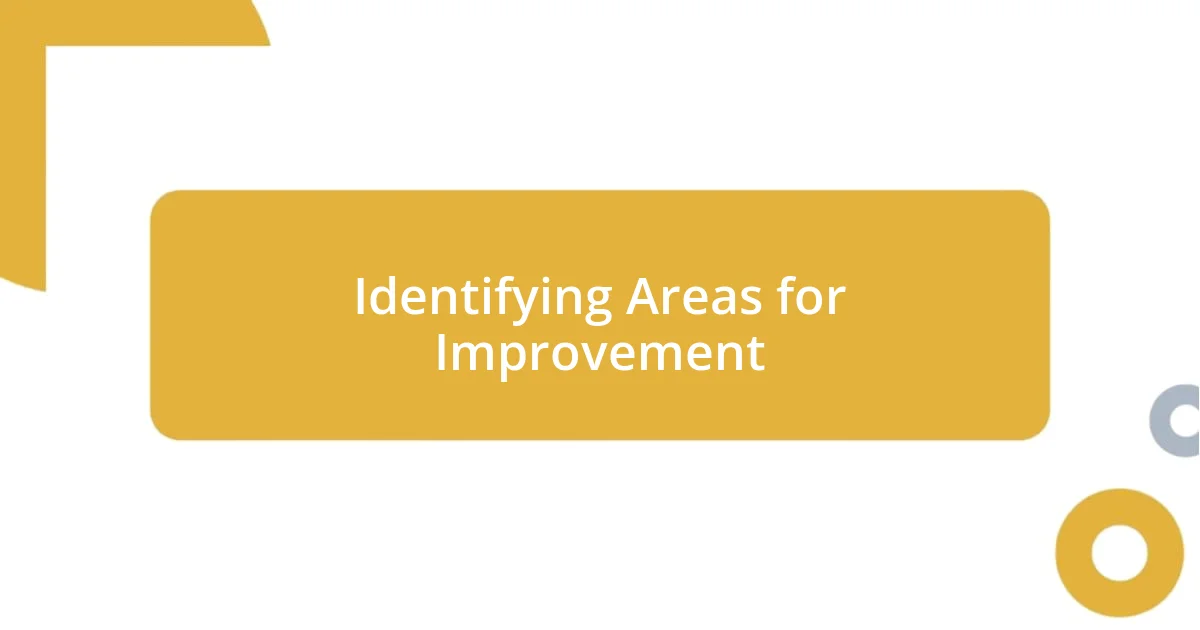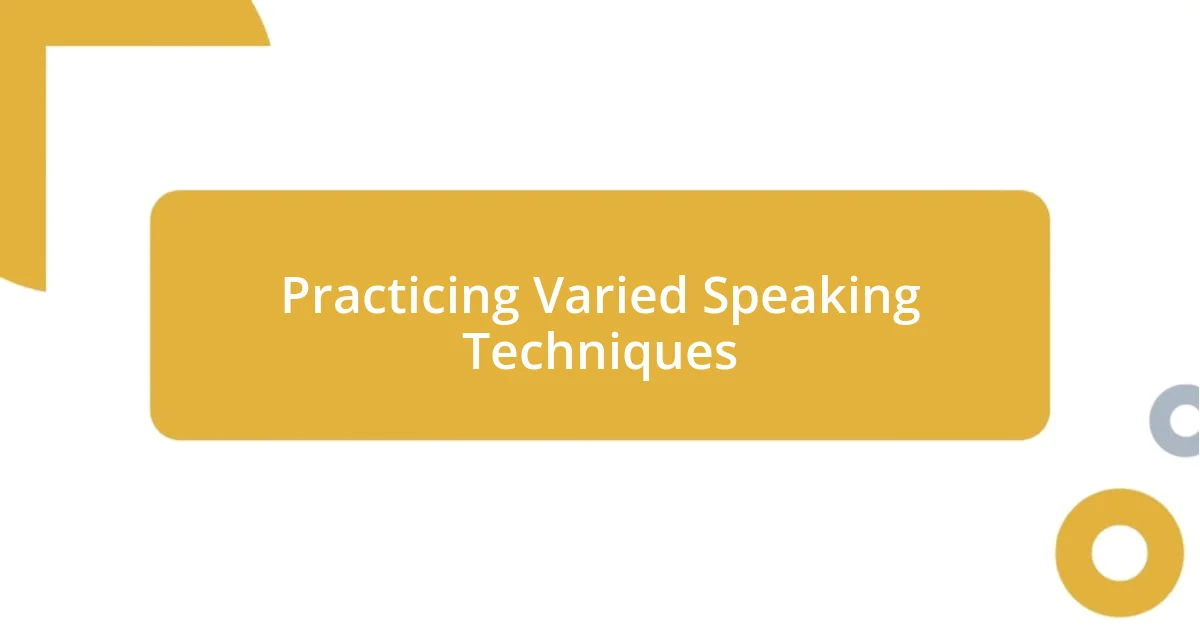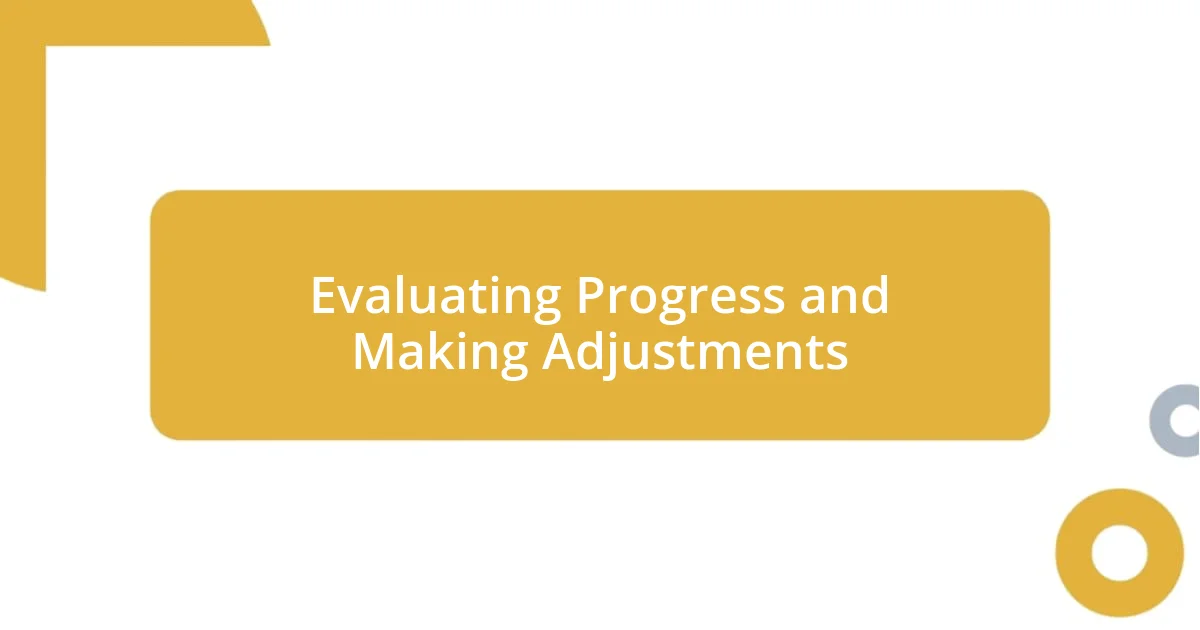Key takeaways:
- Self-evaluation and feedback are crucial for identifying weaknesses and improving speaking style, including pacing, clarity, and engagement.
- Incorporating varied techniques such as tone variation, storytelling, and pauses enhances delivery and audience connection.
- Recording speeches allows for reflective analysis, helping to track progress and make necessary adjustments for future presentations.

Understanding Your Current Style
Understanding your current speaking style is a journey of self-discovery. I remember the moment I realized that I often rushed through presentations, driven by nerves and a desire to cover all my points. Can you relate to that? Taking a step back to evaluate how I communicate has made all the difference.
Pay attention to the feedback you receive. I once conducted a casual survey among my friends and colleagues about my speaking habits. The responses were eye-opening! Some mentioned my tendency to use filler words like “um” and “like,” which I had never noticed in myself. This kind of insight not only highlighted my weaknesses but also pointed toward areas for improvement.
It’s also essential to observe your body language and tone. I find that embracing pauses can enhance my presence and convey confidence. Have you ever tried pausing mid-sentence? It initially felt awkward for me, but now I see the power it holds in letting my words resonate. Realizing how these facets shape my style has been invaluable in my evolution as a speaker.

Identifying Areas for Improvement
Identifying areas for improvement in my speaking style has been both challenging and enlightening. I vividly recall a moment during a workshop where I delivered a presentation. While I thought my content was solid, my audience seemed disengaged. It hit me hard when I realized that my pacing and monotonous tone were barriers to effective communication. Such moments force you to take a hard look at your strengths and weaknesses.
To foster improvement, I now regularly assess my speaking habits by focusing on specific aspects:
- Pacing: Am I speaking too quickly or too slowly?
- Volume: Is my voice projecting enough to capture attention?
- Filler Words: How often do I use “um,” “uh,” or “like”?
- Engagement: Do I connect with my audience through eye contact and gestures?
- Content Clarity: Are my ideas expressed clearly and concisely?
This meticulous evaluation helps me pinpoint actionable changes, ultimately pushing me towards a more effective speaking style.

Incorporating Feedback from Audience
Incorporating feedback from the audience has been a game changer for me. After one pivotal talk, several attendees approached me with their thoughts. They shared how my enthusiasm was contagious but also mentioned they lost track of some key points. Taking this to heart, I started actively seeking feedback after every presentation. This simple act encourages dialogue and gives me insights on how my message lands with different audiences.
I’ve discovered that audience feedback is like a mirror reflecting my speaking style. During a community event, a listener pointed out that I often rushed through my key examples. At first, I felt defensive, but then I recognized that constructive criticism is essential for growth. I began to incorporate intentional pauses, allowing my listeners time to digest the information I was presenting. This change not only improved understanding but also enhanced my overall connection with the audience.
I also utilize anonymous feedback forms to reduce the pressure for both myself and the audience. Once, after a particularly nerve-wracking speech, I received notes praising my authenticity, but I was also told I could improve clarity in complex sections. Those comments shape my ongoing development by guiding adjustments for future talks. Think about it: when we actively invite input, we open the door to evolving our style in ways we might never have considered alone.
| Feedback Method | Benefits |
|---|---|
| Informal Conversations | Immediate, personal insights; fosters rapport |
| Anonymous Surveys | Encourages honesty; highlights common themes |
| Follow-up Emails | Allows for detailed reflection; deeper connection |

Practicing Varied Speaking Techniques
Practicing varied speaking techniques has truly transformed my delivery. One technique I enjoy is varying my tone and inflection, which keeps my listeners engaged. I remember a particular panel discussion where I adopted a storytelling approach, infusing excitement into my narrative. The energy in the room shifted as I noticed heads nodding and facial expressions lighting up. It’s fascinating how changing your vocal dynamics can create a deeper connection with your audience, isn’t it?
I also find that practicing with different audiences helps me refine my techniques. For instance, I once presented in front of a group of teenagers, and their response was vastly different from a corporate audience. With the teens, I adopted a more casual tone and incorporated humor, which led to laughter and genuine interest. This experience reminded me that not every audience is the same; adapting to their vibes makes a significant difference.
Another technique I regularly use is incorporating pauses effectively. Initially, I used to rush through my presentations, worried about time constraints. However, after realizing the power of silence during a workshop, I began to integrate deliberate pauses. I remember pausing dramatically before revealing a key point, and the anticipation in the audience was palpable. It not only heightened their interest but also allowed them to process the information. How about you? Have you tried experimenting with pauses in your speaking? It can really elevate your delivery.

Learning from Influential Speakers
Learning from influential speakers has been a pivotal element in my journey to evolve my speaking style. I remember watching a TED Talk by a renowned speaker who captivated the entire audience with their authenticity and vulnerability. Their ability to share personal stories while articulating complex ideas made me realize that connecting on an emotional level with listeners could transform my presentations too. Have you ever felt moved by a speaker’s story? I know that feeling now drives me to weave my own experiences into my talks.
Observing the varied styles of excellent speakers teaches me the nuances of delivery. Once, during a workshop, I attended a session led by a dynamic presenter who used humor adeptly to break the ice. I remember laughing along and feeling instantly engaged. Inspired, I started experimenting with light humor in my own presentations, realizing it not only eases tension but also allows for a more enjoyable atmosphere. Isn’t it amazing how a good laugh can forge a connection?
Beyond just content, influential speakers often demonstrate the importance of body language. I recall attending a conference where a speaker’s gestures were so compelling that they overshadowed their words. That realization was an eye-opener for me; I began to consciously practice my gestures and posture. Now, when I stand before an audience, I incorporate purposeful movements that align with my message. It truly amplifies what I’m saying. Have you worked on your body language? It can really enhance the overall impact of your delivery.

Recording and Analyzing Your Speeches
Recording my speeches has become an essential practice in my journey to improve as a speaker. I remember the first time I played back a recording; it was a bit cringeworthy, yet enlightening. Hearing my own voice helped me identify areas I hadn’t noticed in the moment, like my tendency to use filler words. It’s surprising how different you sound to yourself compared to how you perceive others hearing you. Have you ever recorded yourself speaking? You might be shocked at what you discover!
When analyzing my recordings, I focus not just on content, but how I deliver it. Recently, I revisited a presentation where I was overly reliant on my notes. I noticed my eye contact was lacking, creating a disconnect with my audience. This reflection guided me to practice more without notes, fostering more natural interactions. Each analysis session feels like peeling back another layer of my delivery, revealing patterns I can improve on. What patterns have you identified in your own speaking?
Now, I actively keep a notebook where I jot down insights from each recording session. It’s almost like a personal diary documenting my evolution as a speaker. I love looking back and seeing my progress, remembering moments where I nailed a punchline or connected deeply with my audience. It brings fulfillment unlike anything else when I see that my hard work is paying off. Isn’t it rewarding to track your journey?

Evaluating Progress and Making Adjustments
Evaluating my progress as a speaker is an ongoing process that I genuinely enjoy. After every presentation, I take a moment to reflect on what resonated with the audience and what fell a bit flat. Recently, I delivered a presentation filled with passion about a topic I love, but afterward, I realized I had rushed through key points. Have you ever felt that disconnect between what you intended to communicate and how it was received? I know that feeling all too well, and it drives me to keep refining my style.
Making adjustments is just as important as reflecting on my experiences. I remember a time when feedback from a trusted friend revealed that my pacing was uneven. It felt challenging to hear, but it was a crucial insight. To tackle this, I started timing my speeches and incorporating pauses for effect, which not only gave my audience time to absorb my points but also helped me to breathe and stay centered. Isn’t it fascinating how minor tweaks can lead to major improvements?
I find that progress isn’t just about the big wins; it’s in the small victories too. For instance, I’ve begun to embrace the power of vulnerability in my speeches, inviting my audience into my personal journeys. While doing this, I can feel a genuine connection forming. That realization hit me after a presentation when several attendees approached me to share their own stories. What a beautiful exchange that was! Tracking these moments of connection has encouraged me to keep pushing the boundaries of my comfort zone. Have you discovered your own moments of connection that inspire growth?















